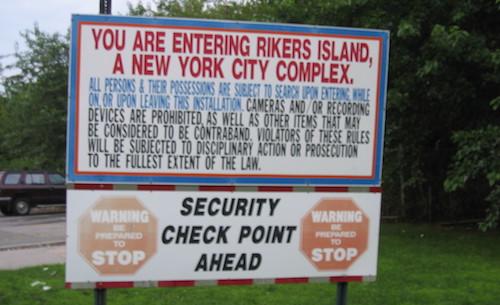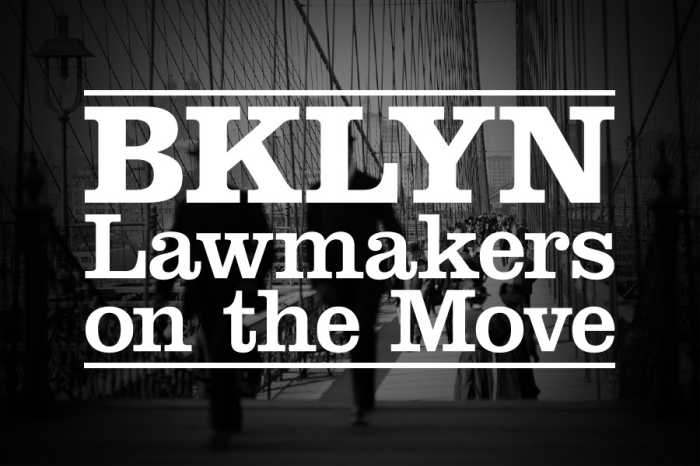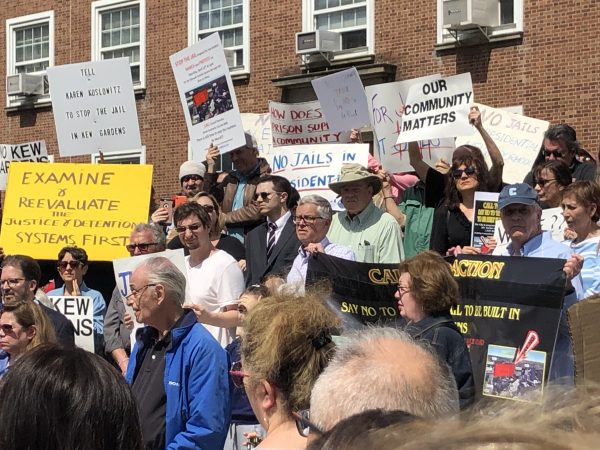Mayor Bill de Blasio and City Council Speaker Corey Johnson today announced the city will begin transferring up to 5,000 of the 9,000 current Rikers Island jail detainees to three existing Department of Corrections (DOC) jails in Brooklyn, Queens, Manhattan and the Bronx as early as next year.
In Queens that means the reopening of the Queens Detention Complex, 126-01 82nd Avenue in Kew Gardens. The facility, which is located behind the Queens Criminal Court Buildig, was closed 16 years ago and has an inmate capacity of 467.
Most recently, the complex has been used for office space and for television and film shoots, including the Netflix series “Orange is the New Black.”
De Blasio and Johnson made the announcement with the city council members representing the areas where the jails are located and said all have agreed to a single public review process for transfers to the existing jail sites.

“This agreement marks a huge step forward on our path to closing Rikers Island,” said de Blasio. “In partnership with the City Council, we can now move ahead with creating a borough-based jail system that’s smaller, safer and fairer. I want to thank these representatives, who share our vision of a more rehabilitative and humane criminal justice system that brings staff and detainees closer to their communities.”
“Today is a historic day, as we are yet one step closer to closing Rikers Island. The New York City Council is proud to have spearheaded the historic Close Rikers movement by creating the Lippman commission and passing legislation enacting many of its recommendations. The Council has also funded innovative programming to keep cases out of the criminal justice system altogether, such as the CLEAR and HOPE programs, which provide treatment instead of incarceration to those with substance abuse issues,” said Johnson.

“The reopening of the Queens Detention Center not only makes sense but is the right thing to do,” said Council Member Karen Koslowitz (D-Forest Hills, Forest Park, Kew Gardens, Rego Park, Richmond Hill). “This proposal restores the Center back to its original purpose and ensure that Queens’ borough-based jail facility is located in our civic center, close to our courts. This smaller facility will bolster the safety for our Department of Correction staff, will create an environment that is more conducive to rehabilitation and will save taxpayer dollars on transportation costs. I look forward to engaging with the residents of my district on this proposal and I thank the Mayor and the Speaker for continuing us down the path of closing Rikers Island.”
These sites in all the boroughs will need to go through a public review – a process known as the Uniform Land Use Review Procedure (ULURP) – which includes hearings and recommendations by the local community board, borough president, the City Council and the City Planning Commission.
The agreement between the mayor and speaker will consolidate the proposal to renovate, expand or construct jails in Manhattan, Brooklyn, Queens and the Bronx into a single ULURP process, which will allow for a more expedited review. An application could be submitted for certification as early as by the end of 2018, and the design process could begin as early as next summer.
The city first announced plans to close Rikers Island about a year ago. In January, the City selected a vendor to identify sites that will eventually replace the jails on Rikers Island. The vendor, Perkins Eastman, and its subcontractors are creating a master plan with recommendations for how to maximize capacity at each of the sites and design jails that best meet the needs of inmates, staff and communities.
The company will also carry out a public engagement process with local communities and stakeholders, and incorporate the feedback and needs of communities into the planning process. In order to expedite the pre-ULURP process, the city will simultaneously carry out environmental reviews to ensure these projects will not have an adverse effect on the surrounding communities.










